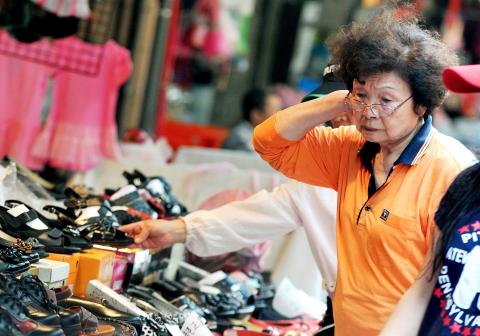Economic growth in the first quarter came in at a disappointing 1.54 percent, weighed down by sluggish exports and private consumption, government data showed yesterday.
The figure was barely half of the 3.26 percent growth estimated by the Directorate-General of Budget, Accounting and Statistics (DGBAS) in February.
“Weaker-than-expected global economic sentiment in the first quarter dragged down [Taiwan’s] export momentum,” DGBAS senior executive officer Jasmine Mei (梅家瑗) told a press conference.

Photo: Mandy Cheng, AFP
The slowdown in China and the EU affected Taiwan’s exports of information and communications technology products during the January-to-March period, Mei said.
Exports rose 2.4 percent year-on-year in the first three months, far behind the 4.71 percent growth rate forecast by the government in February, the DGBAS said.
Stagnant wages also led to sluggish private consumption, which rose only 0.35 percent from the previous year and lagged behind the 1.57 percent forecast by the DGBAS.
The slower increase in private consumption shaved 0.69 percentage points from the agency’s GDP growth forecast.
Meanwhile, fixed-capital formation maintained its momentum, climbing 10.64 percent in the first quarter from a year earlier and outpacing the government’s forecast of 5.63 percent growth.
The DGBAS attributed the increase to strong capital expenditure by semiconductor companies.
Council for Economic Planning and Development Minister Kuan Chung-ming (管中閩) said he was surprised by the low private consumption number.
Earlier this year, Kuan said the council was aiming for economic growth of more than 4 percent this year.
However, to reach that number, GDP growth in the remaining quarters will have to be higher than 5 percent, which is unlikely, he said yesterday.
Still, the rise in private investment was an indication that companies were positive about the economic outlook, he said.
The DGBAS maintained its full-year growth forecast at 3.59 percent, but said it would release an economic update on May 24.
Credit Suisse AG yesterday cut its full-year growth forecast for Taiwan to 2.7 percent from its prior estimate of 3.4 percent.
“We think the recent weakness in export order flows suggests that export growth could continue to stay moderate in the second quarter,” Credit Suisse economist Christiaan Tuntono said in a research note.
Tuntono said he expected the DGBAS and other market watchers to revise downward their full-year growth forecasts soon.
With the downside risk on growth rising, there is a chance that the central bank would cut the rediscount rate this year, if global demand further disappoints, Tuntono said.
National Central University professor Dachrahn Wu (吳大任) was more optimistic, saying the nation could still see more than 3 percent GDP growth this year, on the back of expectations that exports would improve along with a steady economic recovery in the US and Europe in the remaining quarters.
Additional reporting by Camaron Kao

STEEP DECLINE: Yesterday’s drop was the third-steepest in its history, the steepest being Monday’s drop in the wake of the tariff announcement on Wednesday last week Taiwanese stocks continued their heavy sell-off yesterday, as concerns over US tariffs and unwinding of leveraged bets weighed on the market. The benchmark TAIEX plunged 1,068.19 points, or 5.79 percent, to 17,391.76, notching the biggest drop among Asian peers as it hit a 15-month low. The decline came even after the government on late Tuesday authorized the NT$500 billion (US$15.2 billion) National Stabilization Fund (國安基金) to step in to buoy the market amid investors’ worries over tariffs imposed by US President Donald Trump. Yesterday’s decline was the third-steepest in its history, trailing only the declines of 2,065.87 points on Monday and

TAKING STOCK: A Taiwanese cookware firm in Vietnam urged customers to assess inventory or place orders early so shipments can reach the US while tariffs are paused Taiwanese businesses in Vietnam are exploring alternatives after the White House imposed a 46 percent import duty on Vietnamese goods, following US President Donald Trump’s announcement of “reciprocal” tariffs on the US’ trading partners. Lo Shih-liang (羅世良), chairman of Brico Industry Co (裕茂工業), a Taiwanese company that manufactures cast iron cookware and stove components in Vietnam, said that more than 40 percent of his business was tied to the US market, describing the constant US policy shifts as an emotional roller coaster. “I work during the day and stay up all night watching the news. I’ve been following US news until 3am

Six years ago, LVMH’s billionaire CEO Bernard Arnault and US President Donald Trump cut the blue ribbon on a factory in rural Texas that would make designer handbags for Louis Vuitton, one of the world’s best-known luxury brands. However, since the high-profile opening, the factory has faced a host of problems limiting production, 11 former Louis Vuitton employees said. The site has consistently ranked among the worst-performing for Louis Vuitton globally, “significantly” underperforming other facilities, said three former Louis Vuitton workers and a senior industry source, who cited internal rankings shared with staff. The plant’s problems — which have not

TARIFF CONCERNS: The chipmaker cited global uncertainty from US tariffs and a weakening economic outlook, but said its Singapore expansion remains on track Vanguard International Semiconductor Corp (世界先進), a foundry service provider specializing in producing power management and display driver chips, yesterday withdrew its full-year revenue projection of moderate growth for this year, as escalating US tariff tensions raised uncertainty and concern about a potential economic recession. The Hsinchu-based chipmaker in February said revenues this year would grow mildly from last year based on improving supply chain inventory levels and market demand. At the time, it also anticipated gradual quarter revenue growth. However, the US’ sweeping tariff policy has upended the industry’s supply chains and weakened economic prospects for the world economy, it said. “Now